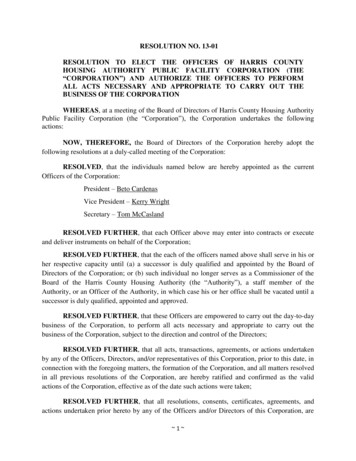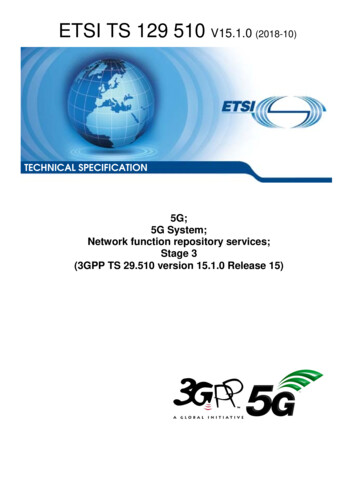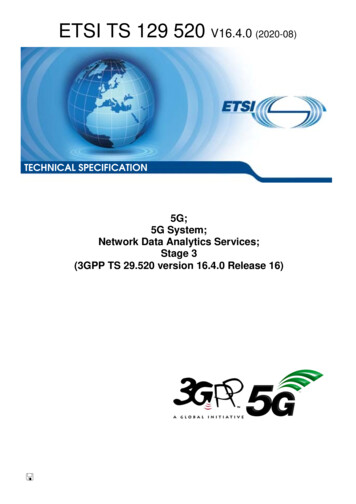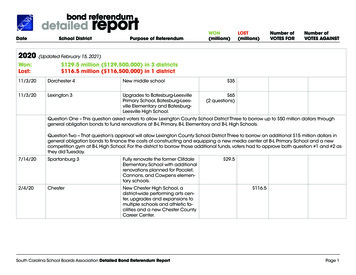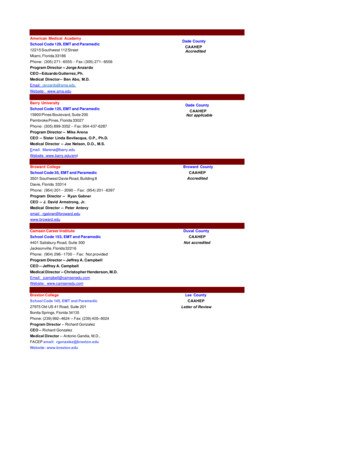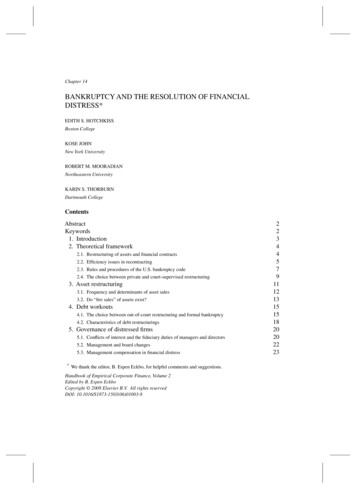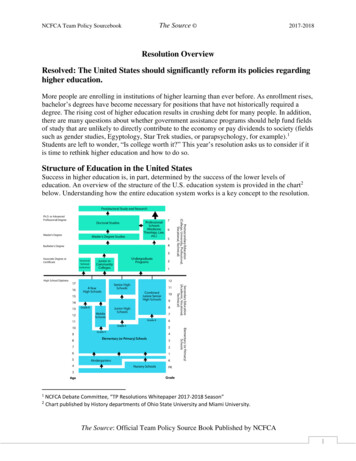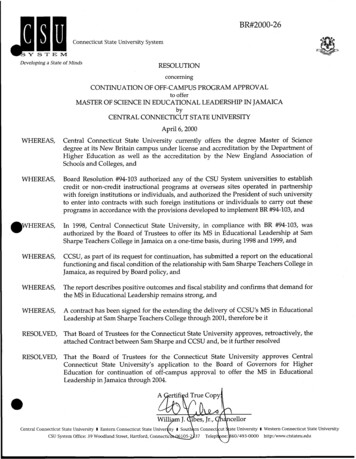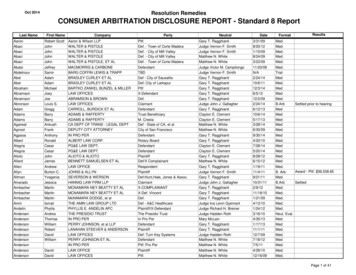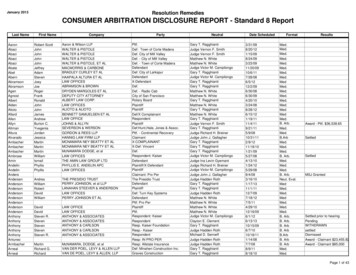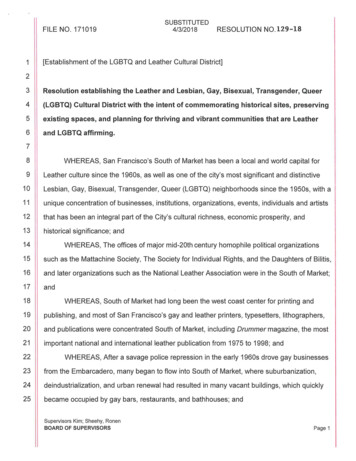
Transcription
SUBSTITUTEDFILE NO. 17101914/3/2018RESOLUTION N0.129-18[Establishment of the LGBTQ and Leather Cultural District]23Resolution establishing the Leather and Lesbian, Gay, Bisexual, Transgender, Queer4(LGBTQ) Cultural District with the intent of commemorating historical sites, preserving5existing spaces, and planning for thriving and vibrant communities that are Leather6and LGBTQ affirming.78WHEREAS, San Francisco's South of Market has been a local and world capital for9Leather culture since the 1960s, as well as one of the city's most significant and distinctive10Lesbian, Gay, Bisexual, Transgender, Queer (LGBTQ) neighborhoods since the 1950s, with a11unique concentration of businesses, institutions, organizations, events, individuals and artists12that has been an integral part of the City's cultural richness, economic prosperity, and13historical significance; and14WHEREAS, The offices of major mid-20th century homophile political organizations15such as the Mattachine Society, The Society for Individual Rights, and the Daughters of Bilitis,16and later organizations such as the National Leather Association were in the South of Market;17and18WHEREAS, South of Market had long been the west coast center for printing and19publishing, and most of San Francisco's gay and leather printers, typesetters, lithographers,20and publications were concentrated South of Market, including Drummer magazine, the most21important national and international leather publication from 1975 to 1998; and22WHEREAS, After a savage police repression in the early 1960s drove gay businesses23from the Embarcadero, many began to flow into South of Market, where suburbanization,24deindustrialization, and urban renewal had resulted in many vacant buildings, which quickly25became occupied by gay bars, restaurants, and bathhouses; andSupervisors Kim ; Sheehy, RonenBOARD OF SUPERVISORSPage 1
1WHEREAS, South of Market quickly became one of San Francisco's major LGBT2areas , in which most of the city's gay bathhouses were located, as were innumerable bars3catering to diverse populations, such as lesbian bars the Hula Shack and the Baybrick Inn,4famous dance bars such as the Stud and the End-Up , featured in Tales of the City, and most5recently , the drag-focused Oasis; and6WHEREAS, The first gay leather bar in the South of Market, the Tool Box, became7world famous when a photo of its interior, with a massive mural painted by local artist Chuck8Arnett, was featured in a 1964 Life magazine article on "Homosexuality in America ;" and9WHEREAS, South of Market became most identified with the emerging Leather10community in San Francisco, when leather bars such as Fe-Be's, the Ramrod, and the In11Between (now the site of the Powerhouse) opened along Folsom Street, starting the formation12of a distinctive leather neighborhood; and13WHEREAS , By the late 1960s Folsom Street had already acquired the nickname of14"The Miracle Mile" in maps and travel gu ides of San Francisco , codifying a leather character15that expanded dramatically throughout the 1970s, such that by 1980 there were at least thirty16South of Market bars , baths, shops, and restaurants serving the leather population, and the17area had the largest and most dense concentration of leather institutions anywhere in the18world; and19WHEREAS, Much of leather social life was produced by the leather motorcycle clubs20and leather social organizations, which used the physical spaces, buildings , and streets South21of Market for their meetings, gatherings, and events , and which have engaged in long22traditions of raising funds for charitable causes; and23WHEREAS , Leather places and groups sparked an explosion of art and iconography,24much of it generated by dozens of artists and photographers and sculptors whose work25adorned the bars and baths and club insignia, and who were featured in galleries such asSupervisors Kim ; Sheehy, RonenBOARD OF SUPERVISORSPage 2
1Fey-Way, 544 Natoma, 80 Langton , and later, Mark I Chester's studio, as well as in the many2art shows that were regularly displayed on the walls of bars such as the Ambush and the3Eagle; and4WHEREAS, South of Market institutions and personnel were centrally involved in the5construction of political organizations such as the Tavern Guild, which helped mitigate the6routine police harassment of LGBTQ individuals and businesses, and give San Francisco its7current queer friendly politics and reputation; and89WHEREAS, During the AIDS epidemic, using the models of mutual aid practiced by themotor cycle clubs, leathermen became leaders in combating the epidemic, established1Oinstitutions such as the AIDS Emergency Fund, and raised hundreds of thousands of dollars11to provide direct assistance for people with AIDS and HIV; and12WHEREAS, Sex educators and AIDS activists from the leather community developed13and effectively disseminated some of the earliest and most comprehensive safer sex14guidelines and practices; and15WHEREAS, Despite the general consensus among public health professionals that the16gay bathhouses were opportunities to promote safer sex practices, the city was swayed by a17campaign that erroneously blamed the bathhouses for the AIDS epidemic, and adopted18regulations that effectively closed the existing bathhouses and sex clubs in San Francisco,19badly damaging the gay and leather economies located in South of Market and drastically20reducing the gay and leather presence in the neighborhood; and21WHEREAS , Since the 1960s, South of Market has experienced relentless pressure22from the urban renewal and redevelopment projects in and around the Moscone Center and23Yerba Buena Complex, which have displaced thousands of residents and small businesses in24favor of capital intensive civic construction and private developments; and25Supervisors Kim; Sheehy, RonenBOARD OF SUPERVISORSPage 3
1WHEREAS, The Leather and LGBTQ presence South of Market continues to be2imperiled by the displacement caused by rising rents and land costs resulting from the3ongoing economic and physical reconstruction of much of South of Market, particularly the4current building boom of high end housing and retail and the escalating competition for5commercial space ; and6WHEREAS , Although the first Folsom Street Fair was founded in 1984 as a protest7against the impact of such redevelopment on the South of Market, the Folsom Street Fair8evolved into an annual event that is the largest celebration of leather sexuality in the world ,9drawing hundreds of thousands of visitors to what has become a major international festival ,10while the smaller and more local Up Your Alley, begun as an AIDS fundraiser in 1985, is also11a major tourist destination , and both of these street fairs are vivid and cherished expressions12of the leather cultural character of the neighborhood; and13WHEREAS , The Western SOMA Citizens Planning Taskforce , established by the14Board of Supervisors in 2004 , worked for almost a decade, consulting with multiple15stakeholders in the area in a collaborative planning process, to formulate a plan for16sustainable development that would enhance the existing neighborhood rather than destroy it,17and whose Western SOMA Community Plan was adopted by the Board of Supervisors in182013 , also included proposals for a Filipino social heritage district (Recognizing, Protecting19and Memorializing South of Market Filipino Social Heritage Neighborhood Resources) and an20LGBTQ social heritage district (Recognizing, Protecting and Memorializing South of Market21LGBTQ Social Heritage Neighborhood Resources) ; and22WHEREAS, The importance of Leather and LGBTQ South of Market has been23recognized in the National Park Service LGBTQ Theme Study (LGBTQ America: A Theme24Study of Lesbian, Gay, Bisexual, Transgender, and Queer History) , as well as in the Citywide25Supervisors Kim ; Sheehy, RonenBOARD OF SUPERVISORSPage 4
1Historic Context Statement for LGBTQ History, and the South of Market Historic Context2Statement of the San Francisco Planning Department; and34WHEREAS, The San Francisco Leather History Walk on Ringold Alley, and the futureEagle Plaza , are physical manifestations of the rich leather heritage of South of Market; and5WHEREAS , The boundaries of the District are defined as the south side of Howard6between 7th Street and Highway 101 , to the west side of 7th between Howard Street and7Harrison St, to Interstate 80 between 7th Street and Division Street, to Highway 101 between8Interstate 80 and Howard Street; as well as the south side of Harrison Street from 7th Street9to 5th Street, the west side of 5th Street from Harrison Street to Bryant Street and the north1Oside of Bryant Street from 5th Street to 6th Street and the west side of 6th Street from Bryant11Street to Harrison Street, and these boundaries contain the greatest concentration of Leather12landmarks, businesses, institutions, organizations, and festivals ; and13WHEREAS, Despite decades of relentless economic pressure , many challenges , and14substantial displacement, there are still vibrant Leather and LGBTQ communities and15institutions South of Market, and South of Market remains the cultural heart of the region 's16Leather culture as well as a world-renowned Leather capital; now, therefore, be it17RESOLVED , That the Board of Supervisors of the City and County of San Francisco18("the Board '') to secure the future of Leather and LGBTQ in South of Market, to stabilize its19institutional structures, and to enhance its economic vitality and physical environment,20therefore establishes the Leather and LGBTQ Cultural District (District) ; and, be it21FURTHER RESOLVED , That the Board endorses the goals:221) To preserve, advance , and promote San Francisco's Leather & LGBTQ Cultural23District as a local , national , and international resource , and as a culturally and commercially24enriched neighborhood and district;25Supervisors Kim; Sheehy , RonenBOARD OF SUPERVISORSPage 5
12) To preserve and strengthen the Leather and LGBTQ communities of San Francisco2by bringing together our diverse histories and cultures at and within the District for all persons3to enjoy and share;43) To create an atmosphere of safety, creativity, vitality, and prosperity for present and5future Leather & LGBTQ neighborhood participants, organizations, institutions, commercial6activity, entertainment, nightlife, events, and street fairs within the District;74) To augment and make sustainable Leather & LGBTQ: housing, commerce ,8community development, cultural resources, physical spaces, and healthcare (in particular,9the healthcare of LGBTQ seniors and those living with HIV); and , be it10FURTHER RESOLVED, That the Board establishes the District to preserve and further11develop the South of Market's past, present, and future Leather and LGBTQ communities and12resources , and to recognize the historical and present contributions of the Leather and13LGBTQ communities; and , be it14FURTHER RESOLVED, That the Board establishes the District to preserve and further15develop Leather and LGBTQ nightlife and commercial corridors within the boundaries of the16district; and, be it17FURTHER RESOLVED, That the Board establishes the District to preserve and18develop housing , services, and health care for Leather and LGBTQ Seniors and people living19with HIV; and, be it20FURTHER RESOLVED , That the Board establishes the District to maintain and further21develop public installations commemorating the history of the District, such as the San22Francisco Leather History Walk on Ringold Alley and the Eagle Plaza, and to support the23creation and maintenance of multi-use community center spaces; and , be it2425FURTHER RESOLVED, That the Board of Supervisors urges the Mayor's Office ofHousing Community Development ("MOHCD"), with advisement from the HistoricSupervisors Kim ; Sheehy, RonenBOARD OF SUPERVISORSPage 6
1Preservation Commission, the Office of Economic Workforce Development, and other relevant2city departments, to implement a community process that leads to the development of a3Leather and LGBTQ District Cultural History and Housing and Economic Sustainability4Strategy ("LCHHESS") to set policies that promote community development and stabilization,5and increase the presence and visibility of the District; and, be it6FURTHER RESOLVED, That other city departments and other bodies may be7requested to be part of the community process to create the LCHHESS, including but not8limited to the Department of Public Health, the Department of Homelessness, the Historic9Preservation Commission, the Aging and Adult Services Commission, the Small Business1OCommission, the San Francisco Arts Commission, the Department of Human Services, the11Department of Aging and Adult Services, the Department of Children, Youth and their12Families, the Office of Community Investment and Infrastructure, the Department of Building13Inspection, the Department of Public Works, the Entertainment Commission, and the Park and14Recreation Department; and, be it15FURTHER RESOLVED, That the LCHHESS as developed by MOHCD through a16community process should be submitted to the Board of Supervisors within 12 months of the17adoption of this resolution.1819202122232425Supervisors Kim ; Sheehy, RonenBOARD OF SUPERVISORSPage 7
City and County of San FranciscoTailsCity HallI Dr. Carlton B. Goodlett PlaceSan Francisco, CA 94 102-4689Resolution171019File Number:Date Passed:May 01, 2018Resolution establishing the Leather and Lesbian, Gay, Bisexual , Transgender, Queer (LGBTQ)Cultural District with the intent of commemorating historical sites, preserving existing spaces , andplanning for thriving and vibrant communities that are Leather and LGBTQ affirming .April 23 , 2018 Land Use and Transportation Committee - RECOMMENDEDMay 01 , 2018 Board of Supervisors - ADOPTEDAyes: 11 - Breed, Cohen , Fewer, Kim , Peskin, Ronen , Safai, Sheehy, Stefani,Tang and Yee1 hereby certify that the for
20 and publications were concentrated South of Market, including Drummer magazine, the most 21 important national and international leather publication from 1975 to 1998; and 22 WHEREAS, After a savage police repression in the early 1960s drove gay businesses 23 from the Embarcadero, many began to flow into South of Market, where suburbanization, 24 deindustrialization, and urban renewal
